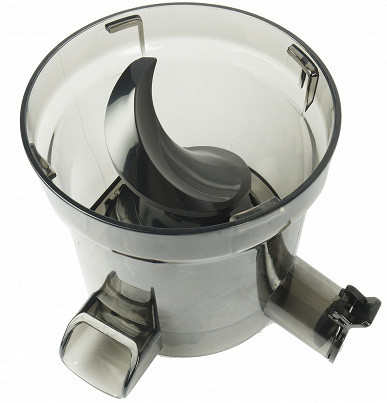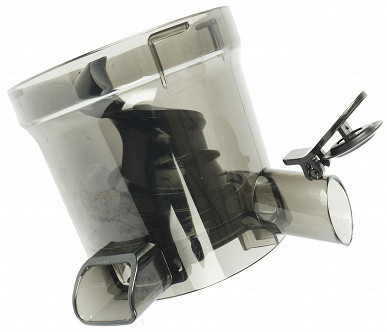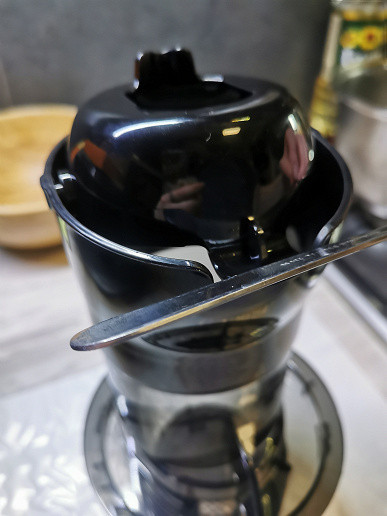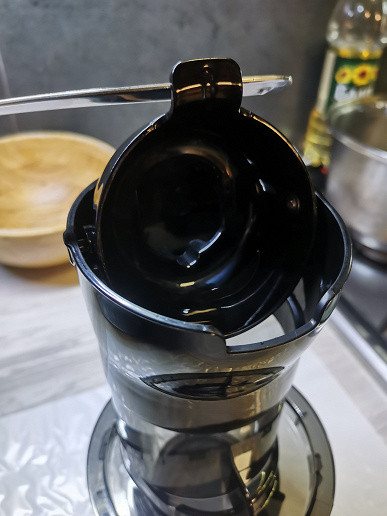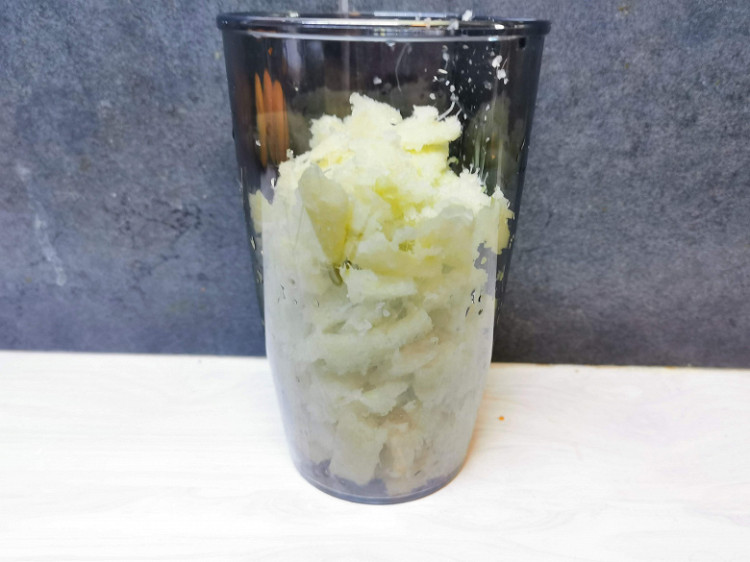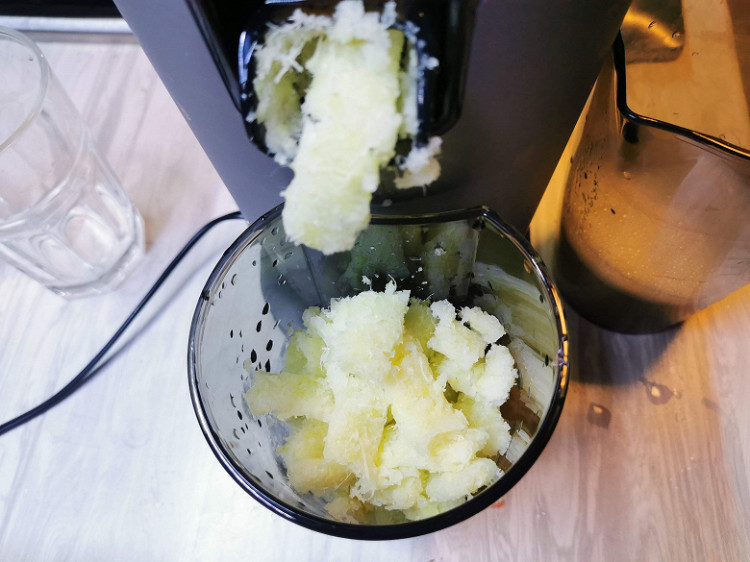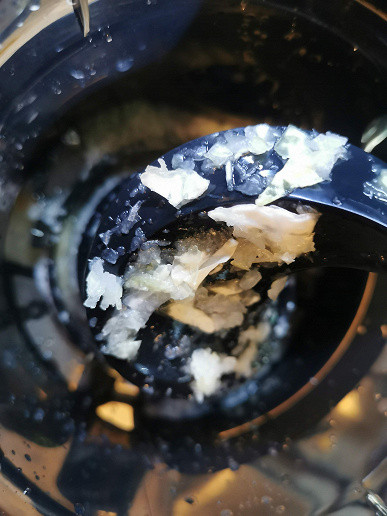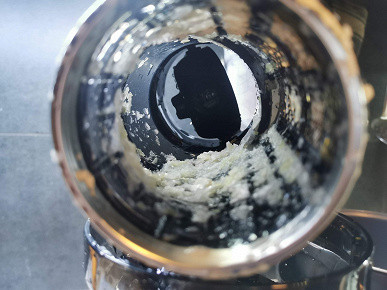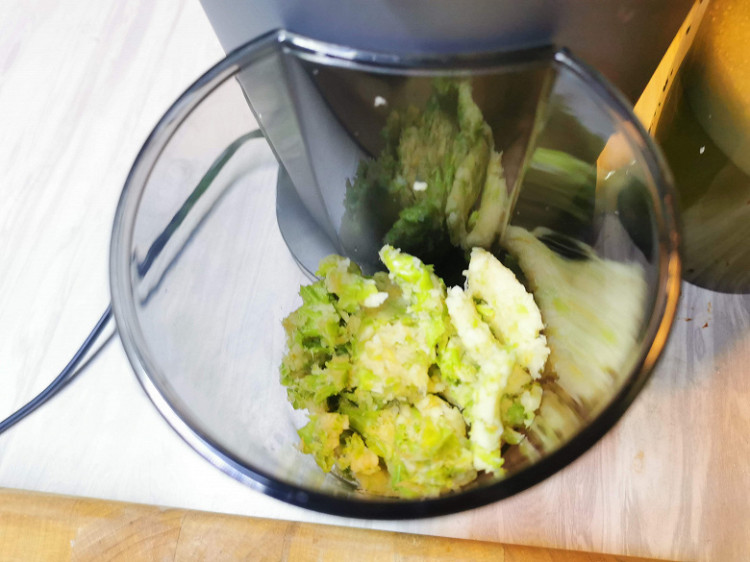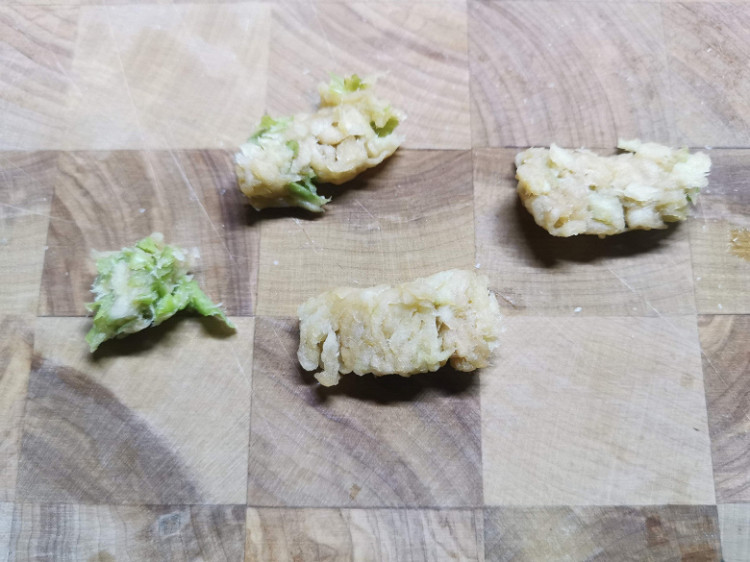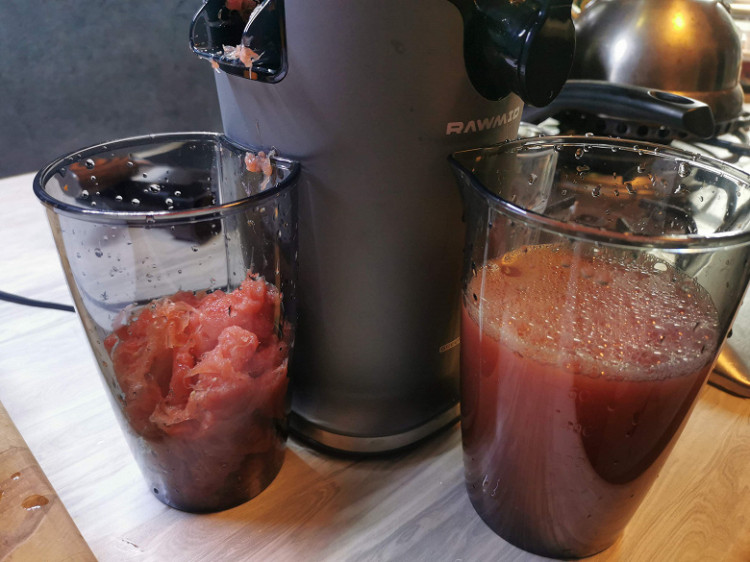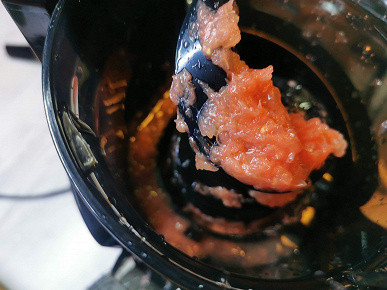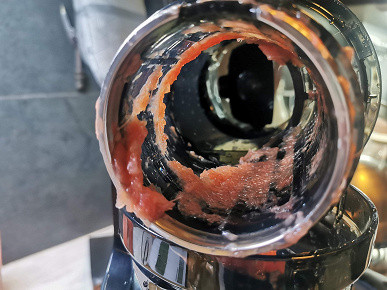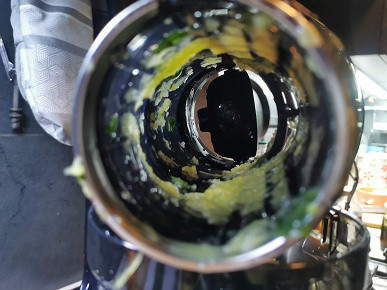Today we are reviewing the Rawmid Greenery RGJ-04 vertical auger juicer. This device is designed for preparing cold-pressed juice, which allows you to preserve all the vitamins thanks to the slow rotation of the auger, differing in this approach from centrifugal analogues.
The juicer has a small loading opening for elongated products measuring only 3.5x4 cm. However, the device has a convenient function for loading wide pieces of food (up to 7.8 cm in diameter) using an overturning container. The model is available in two color options — silver-black and red-black, both of which look neat and uncluttered. In addition, the juicer has a compact size, a reverse function and protection against leakage.
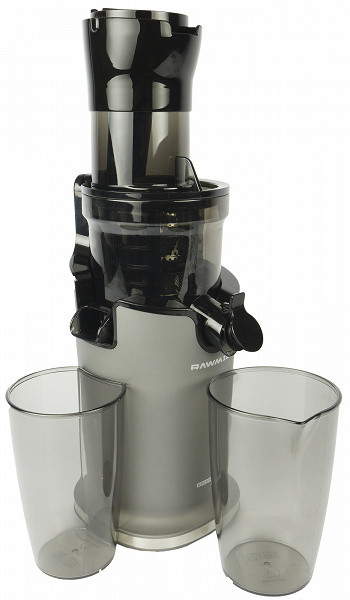
As usual, we will conduct a series of mandatory practical tests to evaluate the versatility of this device and its ability to squeeze juice from vegetables, fruits and herbs of different densities. We'll also measure noise levels, check ease of cleaning and maintenance, and determine its place in our ranking of auger juicers.
Characteristics
| Manufacturer | Rawmid |
|---|---|
| Model | RGJ-04 |
| Type | Auger juicer |
| Country of Origin | China |
| Guarantee | 2 years |
| Declared power | 200 W |
| Noise level | not specified |
| Case color | silver-black, red-black |
| Housing material | stainless steel, plastic |
| Screw material | plastic |
| Separator material | stainless steel, plastic |
| Control | mechanical |
| Rotational speed | 50-60 rpm |
| Operating modes | 1 speed + reverse |
| Protection | from improper assembly, from leakage and overheating |
| Dimensions of the juicer loading opening | for oblong products — 3.5x4.5 cm, for short ones — 7.8 cm |
| Juice/press container volume | 800/600 ml |
| Network cable length | 0.9 m |
| Weight of the juicer when assembled | 2.5 kg |
| Assembled size of the juicer (W×H×D) | 179×442×147 mm |
Equipment
The juicer arrived in two boxes: an outer one, made of corrugated cardboard with minimal information, and an inner black box, which already contains detailed information about the device.
The outer box features a vector image of the juicer, along with its model and specifications. The main advantages of the device are listed on the side faces.
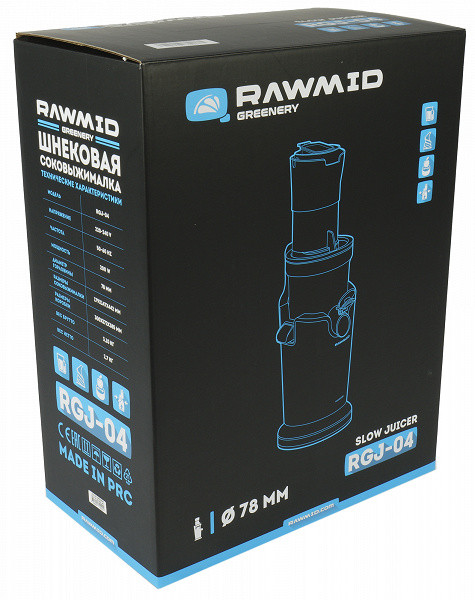
Having opened the box, inside we found:
- pusher
- bowl with two holes
- screw
- squeezing basket
- loading neck with sieve
- glass for cake
- juice glass
- motor block
- brush
- instructions and warranty card
Each part of the juicer is packed in a plastic bag and also placed in foam inserts.
At first sight
After assembling the juicer, it became clear that its dimensions are really compact. The height of the device from the legs to the edge of the loading neck is only 44 centimeters, and the width is 17 cm.
This device can be easily installed in a standard kitchen. It is only important to leave a little space from the hanging kitchen cabinet so that it is convenient to load food. The juicer feels reliable thanks to the heavy and stable motor unit with suction cups and molded parts.

On top of the motor block there is a mount for a plastic basket with an auger installed in it.
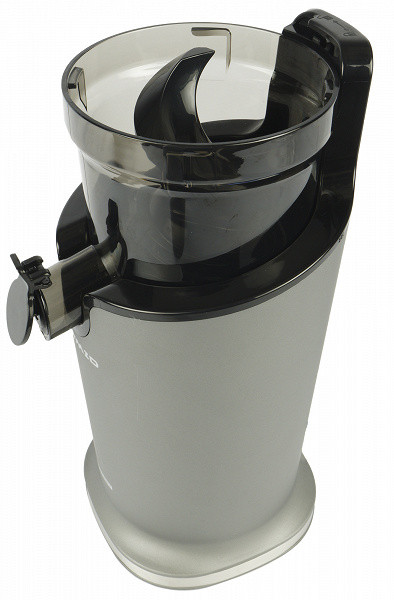
The juicer bowl is made of transparent plastic and equipped with two spouts: one is designed to release juice, and the other is for pulp.
The juice outlet is equipped with a rubberized plastic valve with a small handle. This valve pauses the juice flow, allowing you to mix juice from different ingredients directly in the bowl and prevents drips when changing the juice container.
The hole for the pulp is slightly wider and is closed with a rubber tongue inside the bowl.
Also in the middle of the bowl there is a cone-shaped elevation with a rubber ring on top. It is in this place that the auger, installed together with the grater inside the bowl, will be connected to the rotating shaft of the motor block.

The screw is made of shockproof black plastic. At the base of the auger there is a mount that connects it to the motor unit.
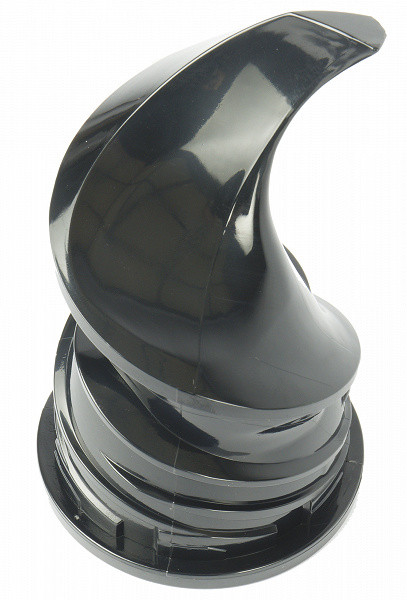
The lid with the loading neck is made of plastic and has the shape of a black container that turns over. There is a hole at the top for long ingredients, and a stainless steel and plastic filter grater is installed at the bottom. The pusher is also made of black plastic.
At first glance, the grater looks like a classic auger juicer — a round mesh funnel with an auger inside. However, upon closer examination, we discovered that the design differs from the standard one: in our case, the sieve is connected to the neck.

The container is a fairly wide object (7.8cm diameter) which makes loading short but large pieces a very easy task. However, the hole for elongated ingredients is narrow (3.5x4 cm), which requires cutting all elongated products into narrow pieces for successful transfer to the auger.

There is a plastic black handle on the juicer bowl, which contains inside a mechanism for connecting the parts of the device. The system only snaps into place when the bowl is correctly installed on the motor unit and the lid with the loading neck on top is correctly secured. If assembled incorrectly, the device will not start.
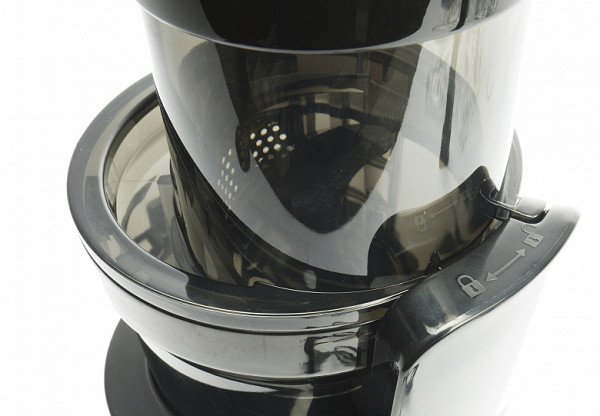
Glasses for juice and pulp are made of transparent matte plastic and equipped with graduations with marks for 300, 400, 500, 600, 700 and 800 ml. They are not fixed to the body and can move freely. The pulp cup has a convenient recess along its entire length on one side, which ensures a tight fit to the motor block.
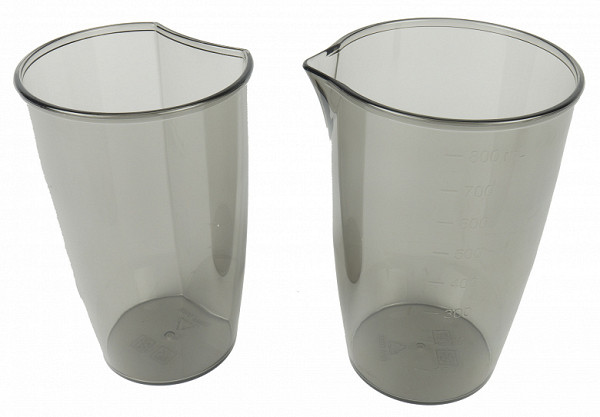
At the bottom of the motor block we see 4 rubber suction cups at the ends of the legs, as well as several ventilation holes and a small nameplate with brief technical information. On the back of the device there is an outlet for the electrical wire.
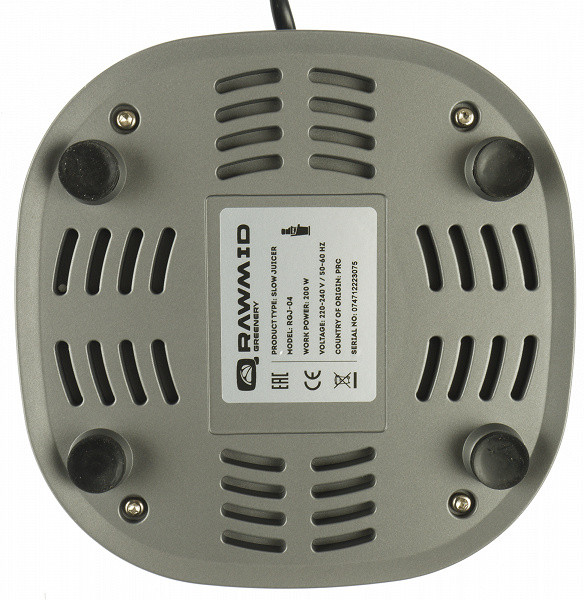
The device also comes with a comfortable narrow black plastic brush with stiff bristles. It will help to deal with stuck fragments of fruits and vegetables in hard-to-reach places in the juicer and especially in the grater.

Instructions
The user manual is presented in a booklet format of A5 size on 24 pages. Of these, 16 pages are occupied by detailed instructions in Russian, and the remaining pages contain the same instructions in English. This manual contains all the necessary information about the device, its use, care and safety precautions.
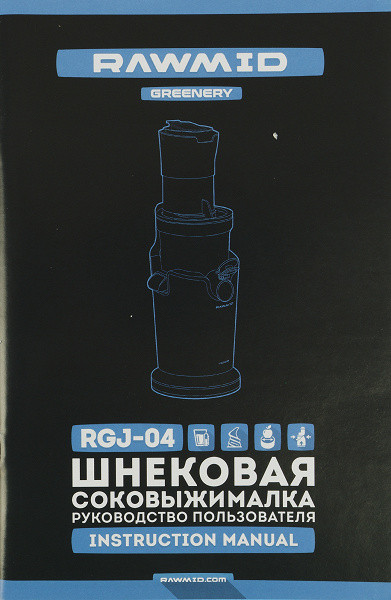
Thanks to simple illustrations in the brochure, you can easily navigate the details of the device and quickly assemble it — this is definitely a plus.
Control
The Rawmid RGJ-04 juicer is controlled using a mechanical switch. Moving the switch to the upper position, in the “—” mode, turns on the normal operation of the device, and moving it down, to the “R” mode, activates reverse rotation of the engine.
The control process is simple and straightforward. To stop the device, simply return the switch to its original position “O”.
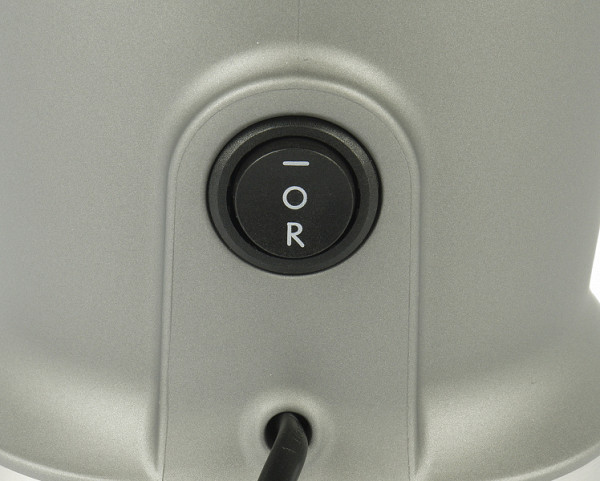
There is also protection against incorrect assembly: if some parts are installed incorrectly, the device will not start working.
Exploitation
Before using the juicer, it is recommended to wash all removable parts with warm water. If necessary, you can use a mild detergent and then dry thoroughly before assembly. The filter grater and motor unit can be wiped with a damp cloth and then dry.
The device has a narrow neck for long ingredients, so it is recommended to pre-cut the products into narrow pieces. The reversible container for loading large and short pieces turned out to be extremely convenient. It allows you to easily add new portions of food during operation, minimizing downtime.
During operation, the juicer fully met expectations. The results of the work were satisfactory. The operating noise of the device was moderate, and the juice preparation process did not take much time.
Overall conclusion: the Rawmid RGJ-04 juicer reliably performs its functions, providing slow and gentle extraction of juice from products. It is suitable for use both in everyday life and in the countryside, even for large families.
Care
To keep your juicer clean and in good condition, wash all dirty parts in warm water immediately after use. It is recommended to clean the filter and auger with a brush. The easiest way to rinse the filter is by first soaking it in warm water and detergent for a while.
The unusual design of the juicer, where the sieve is combined with the neck, makes the cleaning process easier and reduces the number of parts that require washing.
The manufacturer did not provide information about the possibility of using a dishwasher to clean the juicer parts.
Our measurements
When idle, the juicer consumed only 0.1 W of electricity. The power during operation depended on the hardness of the processed products and the speed of operation. On average, it was 130 W, and the maximum power was achieved when squeezing juice from carrots and amounted to 170 W.
The total energy consumption for all tests did not exceed 0.03 kWh.
Noise level during testing:
- up to 79 dBA when chopping hard ingredients such as cabbage, apples and carrots;
- 68 dBA when chopping soft fruits such as grapefruit and oranges.
Practice tests
The method of testing juicers includes a number of mandatory tests. We squeeze exactly one kilogram of a certain type of food: Granny Smith apples, pink grapefruit, cabbage and carrots. Based on the results of measurements, we determine the productivity coefficient, which is the average volume of juice obtained from one kilogram of raw material and the average time spent processing this weight.
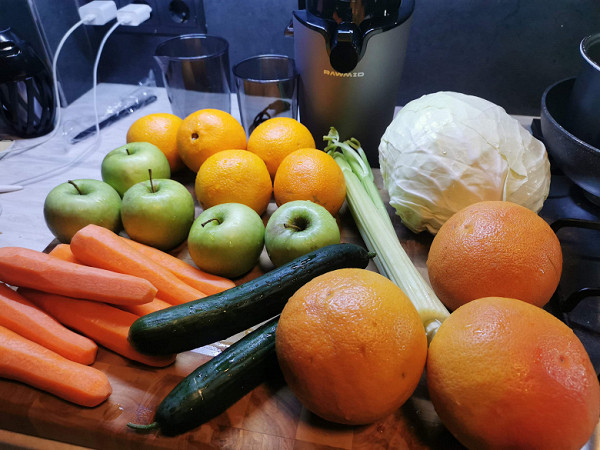
Mandatory test #1: carrots
We weighed a kilogram of carrots, pre-peeled and cut into only the largest root vegetables that did not pass through the loading hole. Most of the carrots easily fit into the juicer whole.
The Rawmid RGJ-04 juicer successfully completed this task in just 3 minutes 40 seconds. The entire volume of carrots was effectively processed, and the result was both juice and cake.

Winter carrots are a bit dry, so there wasn’t as much juice as we would have liked. But nevertheless, we received bright orange homogeneous juice with a minimal amount of delicate light foam.

The cake turned out to be homogeneous, fine, and quite dry.

Some shredded carrots were stuck inside the basket and the reverse function had no effect on moving them.
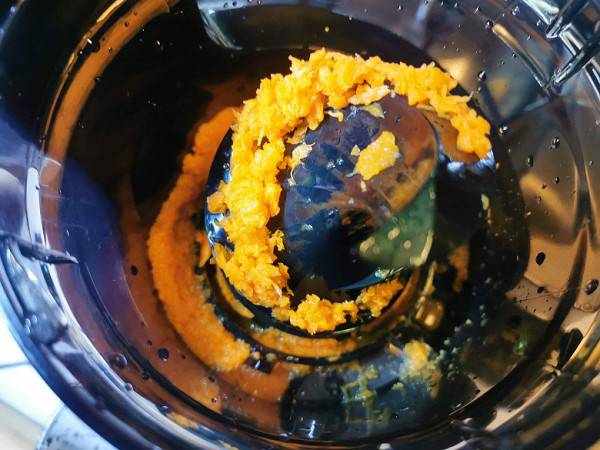
We were pleased with the operation of the juicer: it turned out to be powerful, fast and not too noisy. While working with it, all surfaces remain clean, and juice and pulp are evenly distributed among the appropriate compartments.
Result: in 3 minutes 40 seconds we got 380 grams of juice.
Mandatory test No. 2: white cabbage
For the second test, we finely chopped a kilogram of white cabbage.
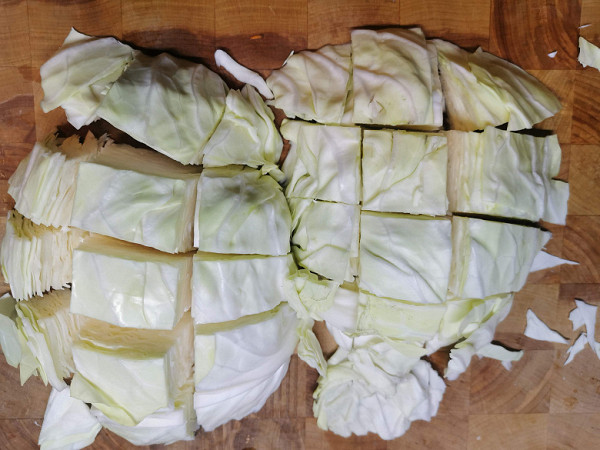
The cabbage shredded easily, sometimes squeaking a little when it got stuck or stuck to the sides of the bowl, but the reverse function helped in such cases. The spinning process was not very fast, especially since it was necessary to load small pieces one at a time and this took longer than usual. However, we received excellent quality sweetish cabbage juice with a lot of airy foam.

We were also pleased with the waste container. The pulp looked uniform, no unprocessed pieces or whole cabbage leaves.
Waste trapped between the grater and auger was minimal.
In 6 minutes we got a glass of juice and in another 35 additional seconds of work the pulp came out.

Result: 486 g of juice in 6 minutes
Mandatory Test #3: Granny Smith Apples
We cut the Granny Smith apples into small pieces, removing the core.
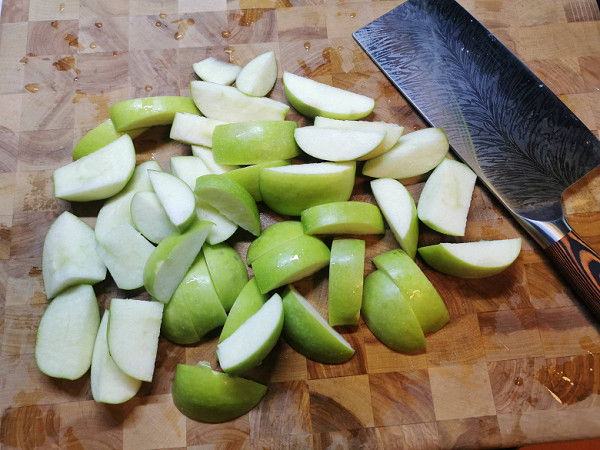
During the extraction process, we quickly got an excellent result — aromatic green juice with a large amount of thick, gradually settling foam.
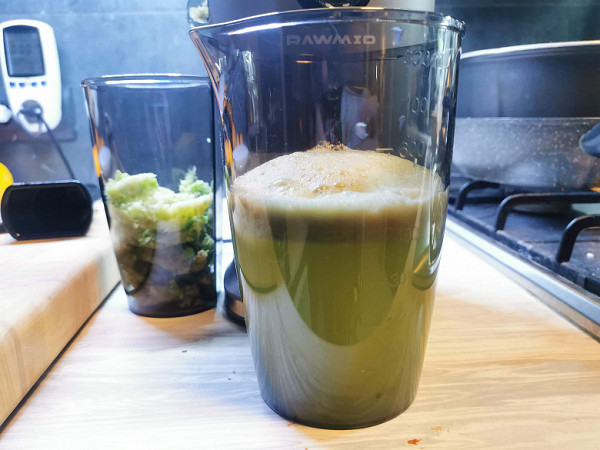
The cake turned out dry and homogeneous again.
We received 654 g of delicious apple juice.
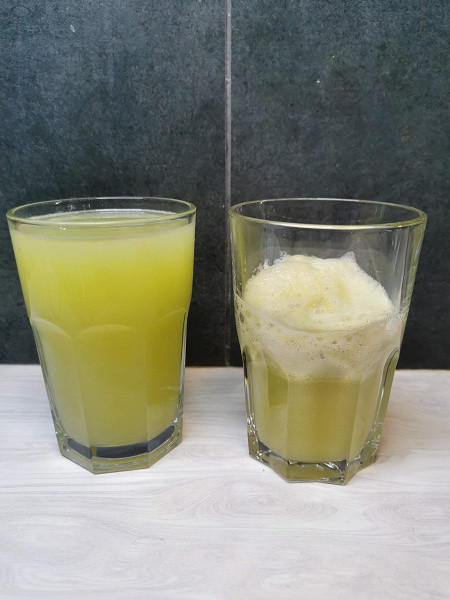
Result: 654 g of juice in 6 minutes 40 seconds
Mandatory Test #4: Pink Grapefruit
For the test, we peeled three large grapefruits and, by removing a couple of slices, we got the kilogram we needed.

The grapefruit was squeezed out very quickly, the fruits were juicy, and we were pleased with the amount of juice obtained. The juice itself was bright and flavorful, with a bit of foam.
Well-wrung out, but still wet briquettes of pulp went into the waste container.
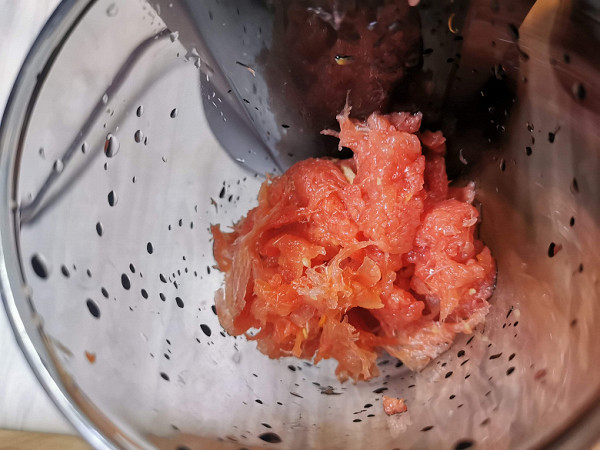
The amount of waste trapped between the grater and auger was found to be appropriate for citrus fruits.
The amount of juice in this test was the maximum — 688 g.
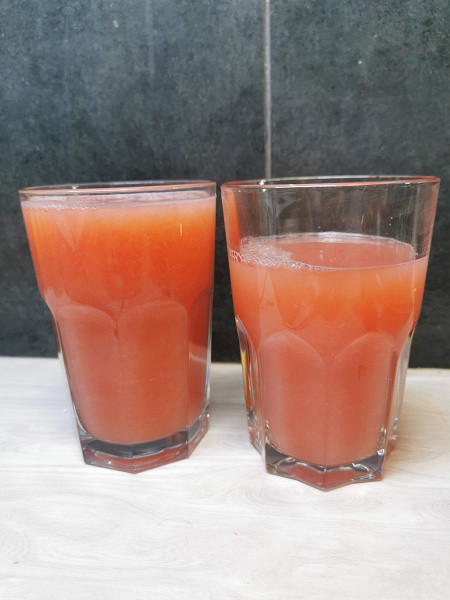
Result: 688 g of juice in 3 minutes 15 seconds
Juice from oranges and bananas
We also decided to test our juicers on fresh oranges and bananas.
To do this, we took 3 large oranges, peeled them and divided them into slices. In addition, we peeled 4 small green bananas weighing about 100g each (the photo shows 3 bananas, we added a fourth in the process). Thus, the total weight of the purified products was 963 grams.

The juicer took 4 minutes, after which we received bright, thick and aromatic juice.
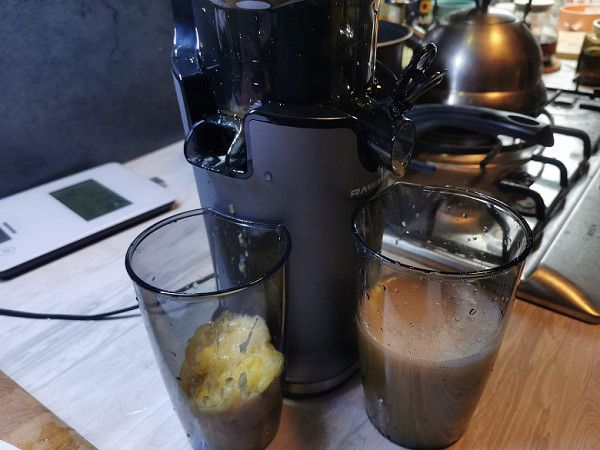
Due to the lack of experience in squeezing juice from bananas, we put this fruit in first, and… it immediately went into the pulp compartment.
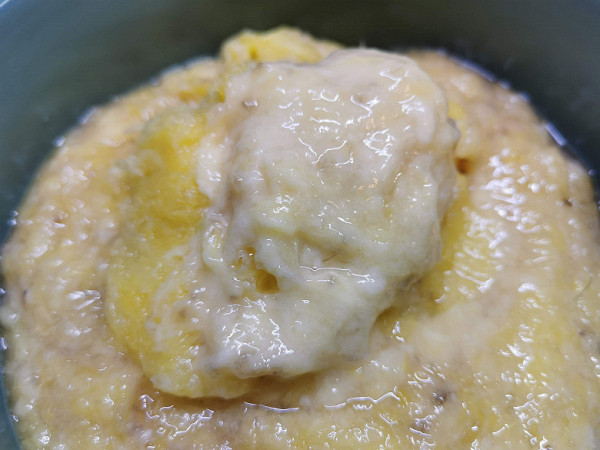
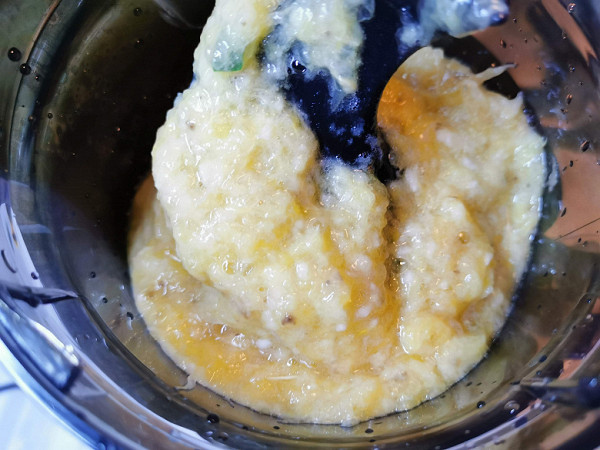
Still, despite this, the juice turned out to be really tasty. We appreciated this juicer model for its speed and satisfactory quantity (466 grams) of this pleasant drink in a glass.

And we also enjoyed eating the resulting tropical mass of juicy pulp as a smoothie.


Result: excellent
Juice from cucumbers, celery stalks and oranges
We also decided to test the juicer on a mixture of ingredients, including stringy celery stalk.
According to the instructions, the celery stalk should be cut into pieces up to 4 cm long, which is what we did. We cut the cucumbers lengthwise and crosswise, and peeled the oranges and divided them into slices. As a result, we prepared 897 grams of products.
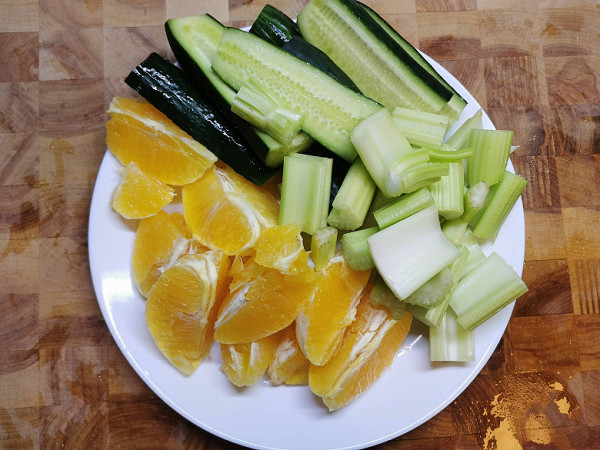
In 3 minutes and 45 seconds, all the pieces were actively crushed by the auger, and we received 518 g of a bright, aromatic and unusual drink.
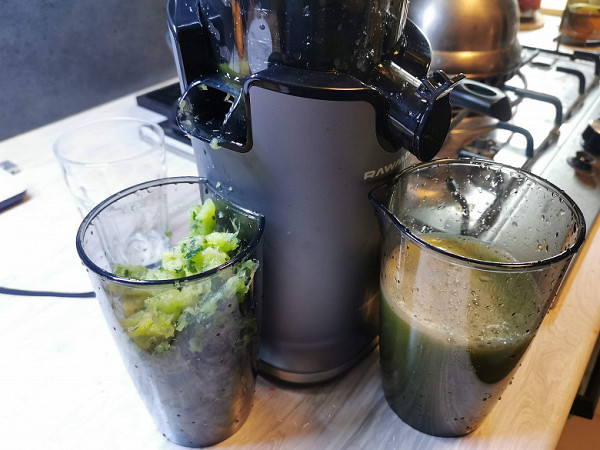
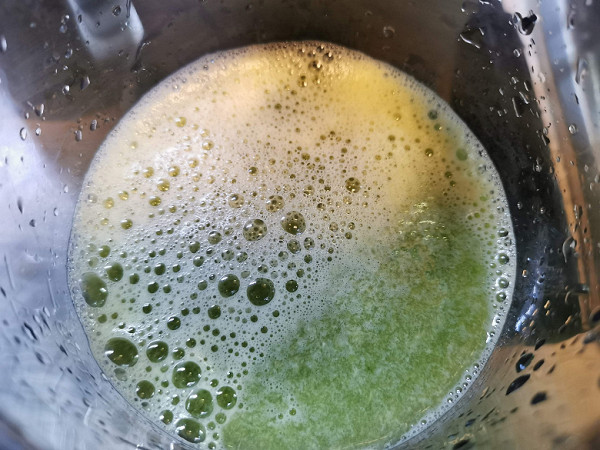
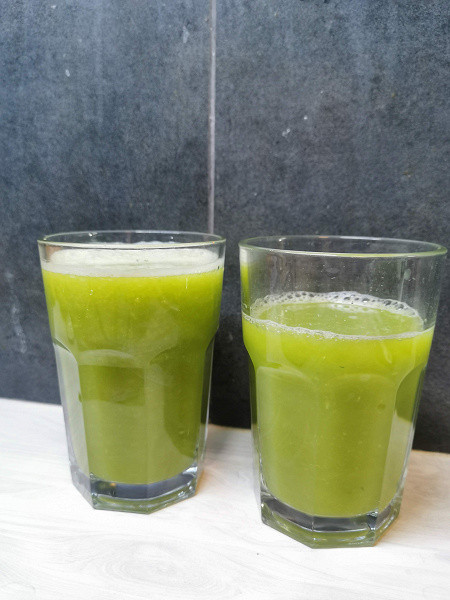
The cake turned out to be homogeneous and dry, and the celery fibers remained intact, which indicates a gentle cold press. This method preserves the maximum amount of trace elements in the juice.
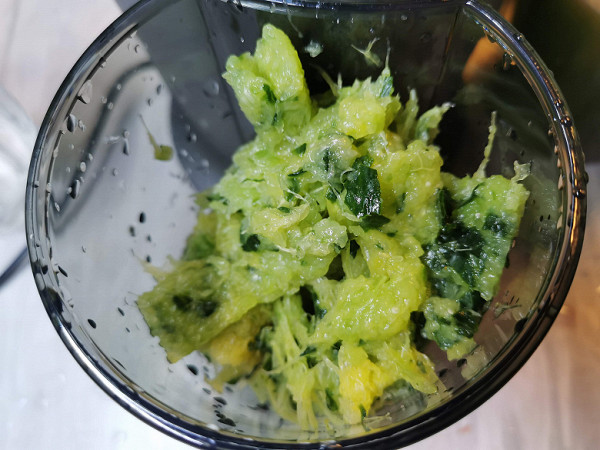
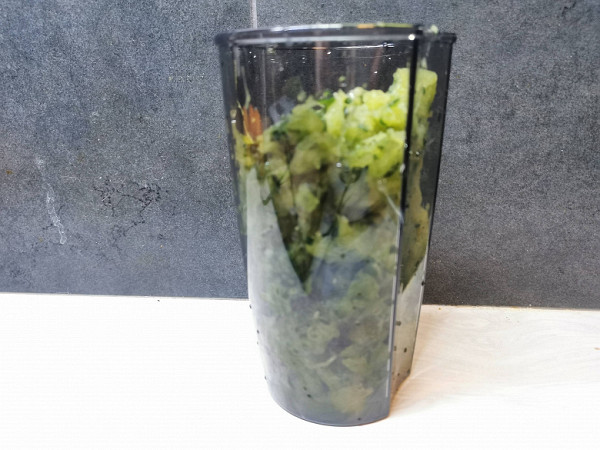
No unprocessed pieces were found inside the bowl, only some fibers and fragments of vegetables and orange peel.
Result: excellent
conclusions
An auger juicer is an excellent solution for those who care about their health and prefer natural, freshly squeezed juices to homemade food. Due to the fact that the device operates in cold mode, does not grind fruits with blades or heat them, the juice retains a maximum of nutrients and does not oxidize.
The Rawmid Greenery RGJ-04 juicer turned out to be convenient and pleasant to use. Among its advantages are ease of assembly and operation, the inability to start it in the wrong assembly, and the absence of splashing of cake on work surfaces. The quality of the cake is assessed as excellent — it is small and well pressed, as is the quality of the juice, which is homogeneous and of high quality.
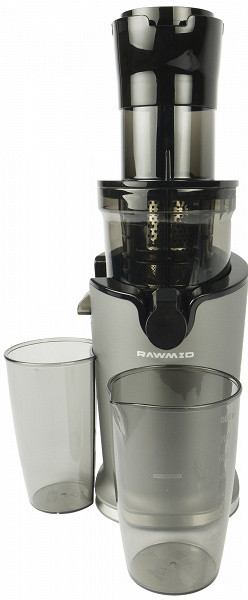
This juicer model has compact dimensions, modest power, but at the same time a reliable motor and high performance. It is suitable both for use in the home kitchen and for working in the country during the fruit and vegetable season. It is important to remember to take breaks every 20 minutes of operation for 5 minutes to rest. Thanks to its small size, it is easy to store. The quality and quantity of juice produced by the device is at a high level, assembly and cleaning are not difficult, and the noise during operation is acceptable.
This device successfully copes with various types of products and will become a reliable assistant in the kitchen.
Pros:
- stylish appearance
- small dimensions
- low power consumption
- excellent performance
- easy assembly
Minuses:
- not the fastest spin

